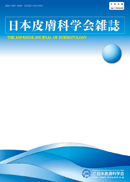
- |<
- <
- 1
- >
- >|
-
[in Japanese]2017Volume 127Issue 12 Pages 2615-2621
Published: November 20, 2017
Released on J-STAGE: November 20, 2017
JOURNAL RESTRICTED ACCESS -
[in Japanese]2017Volume 127Issue 12 Pages 2623-2629
Published: November 20, 2017
Released on J-STAGE: November 20, 2017
JOURNAL RESTRICTED ACCESS
-
Yuko Miyazaki, Takaya Fukumoto, Tetsunori Kimura2017Volume 127Issue 12 Pages 2631-2640
Published: November 20, 2017
Released on J-STAGE: November 20, 2017
JOURNAL RESTRICTED ACCESSWe have studied the clinicopathological features of 19 patients with palisaded encapsulated neuroma diagnosed at our institute during the past 10 years. The patients comprised 10 men and 9 women with a mean age of 53.1 years. The mean diameter of the neoplasms was 4.3 mm. Only one lesion was located on the hand, the other lesions arose on the face. Histopathologically, most of the tumors arose in the dermis. Small normal peripheral nerves adjacent to the tumors were observed in 11 lesions. Fifteen of the 16 capsules were EMA antigen positive. These findings indicate the intraneural growth of PENs. An immunohistochemical study using an antibody to neurofilaments revealed that the number of axons varied among these different PENs.
View full abstractDownload PDF (2907K)
-
Atsushi Yamashiro, Sayaka Yamaguchi, Takuya Oomine, Daisuke Utsumi, Yu ...2017Volume 127Issue 12 Pages 2641-2645
Published: November 20, 2017
Released on J-STAGE: November 20, 2017
JOURNAL RESTRICTED ACCESSA 14-year-old boy suffered from erythematous swelling with tenderness on his eyelids, cheeks, and the dorsal surface of the hands one day after skiing. Because his erythrocyte protoporphyrin level was high, the photo-hemolysis phenomenon and fluorescent erythrocyte tests were positive, and there was hepatic damage, the patient was diagnosed with erythropoietic protoporphyria. A nonsense mutation (c.361C>T, p.R121*) and a low-expression allele (IVS3-48C) were identified in the patient's ferrochelatase gene as a compound heterozygote. His paternal grandmother and cousins had photosensitivity, the same nonsense mutation, and the polymorphism as a compound heterozygote. In contrast, the patient's father and aunt, who did not present any symptoms, had the same nonsense mutation in a heterozygous manner, but had a normal-expression allele (IVS3-48T) on another allele.
View full abstractDownload PDF (584K)
-
2017Volume 127Issue 12 Pages 2647-2658
Published: November 20, 2017
Released on J-STAGE: November 20, 2017
JOURNAL RESTRICTED ACCESSDownload PDF (673K)
- |<
- <
- 1
- >
- >|